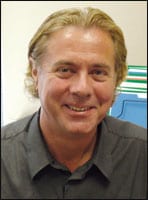Facial plastic surgeon Timothy R. Miller, MD, is meticulous. This serves his patients well, and it also is one of the reasons that it took him some time to open his new private practice—Refreshed Aesthetic Surgery in Aliso Viejo, Calif.
Dr Miller sweats the small stuff. Whether repositioning the last bit of fat during a lower bleph, submitting a manuscript to a peer-reviewed journal, or choosing the marble panels for his new office, he won’t sign off until it’s perfect.
This attention to detail is why many former patients sought Miller out when his doors first opened on December 30, 2013, and also why he has developed a new following in a relatively short time—not an easy feat in such an oversaturated market as Orange County. While he did have a foothold and some name recognition in the area because of time spent at another local practice, it wasn’t easy to start fresh, but he knew he had to try.
“There is never a moment when you say, ‘This is the perfect time’ to open your own practice, but if it is something you want, you need to take a leap of faith,” Miller says. “You gather more and more confidence in yourself and your ability, and eventually you just have to do it or you will have regrets.”
Self-doubt and fear did seep in along the way, and he would reach out to colleagues, friends, and a former fellowship advisor and his parents for counsel and moral support during those times. Of course, there were some hiccups, too, but today, Miller looks at them like growing pains. “It feels like home,” he says.
It has never been easy for plastic surgeons to strike out on their own, but changes in the healthcare landscape—including reimbursement restrictions—have made it even more trying today. In fact, rising numbers of plastic surgeons are actually leaving private practice for group practice or other employed positions. About 50% of all American Society of Plastic Surgeons are still private-practice surgeons, which is different from days past when the overwhelming majority of plastic surgeons were in private practice.
Location, Location, Location
For Miller, magic didn’t really strike until he found the ideal location. “There were a lot of things out there that didn’t fit my style, and then a new medical building was built with easy freeway access from Newport Beach, San Diego, and Riverside,” he says.
The new location had pretty much everything on Miller’s rather extensive checklist—including amazing views. “I held out for the best possible spot within the building for my office, one which would allow my main exam room where I do Botox and fillers and my consult room to provide sweeping views of Orange County,” he says. “I really wanted my patients to have a different and very memorable aesthetic impression and experience, and I wanted those impressions to begin as soon as they parked their car until the time they left the office.”
He contracted with a design firm in Austin, Texas. (Yes, there were many closer to home in Southern California, but he liked what saw in Austin.) Among the first orders of business was the build-out of an American Association for Accreditation of Ambulatory Surgery Facilities-accredited center and a “very luxurious and comfortable” overnight suite. Another must-have was a dedicated photography room, as he is a stickler for technical precision and measuring outcomes in an evidence-based fashion.
Once it was built to perfection, Miller had to fill the office—with both staff and patients. There was a lot of trial and a fair share of error at the beginning, he says. Outsourcing to third-party vendors to help with hiring and other business matters didn’t help set the tone he wanted for his practice.
Ultimately, he opted to create and cultivate his own online footprint, and do all of his own hiring and new patient outreach. “I answer RealSelf questions, and we do a lot of social media to get and keep my practice name out there,” he says. He does work with an Internet firm for search engine marketing, he writes most of his own web content, and he heavily edits all that is supplied for him. He also donates services to local charities. It all seems to be working, as he was just named one of the best cosmetic surgeons by the Orange County Register in its annual “Best of OC” issue for the second year in a row.
“You need to be true to your own style,” he says. “That was the biggest lesson that I have learned.”
Drilling Down
Like most plastic surgeons, he doesn’t look his age (he’s 50), but if he had wrinkles, they would tell a story—that is likely very different from other plastic surgeons.
Before going to college, Miller took a job drilling for natural gas and oil in Northern California. “I wasn’t ready, and I wanted to work and earn a nice living,” he says. “And being a roughneck sounded like a cool job that was physically demanding with an element of danger.” It involved operating heavy machinery and drilling down holes that are 3 miles deep. Eventually, he had his own crew—and yes, they did strike natural gas and oil on several occasions.
But after a few years, “You just realize it’s a young man’s game, and with the constant fluctuation of the price of oil and natural gas, you want a more stable life.”
So he started over. Miller went to college and on to earn his MD at the University of California, Davis School of Medicine. He then completed a 5-year surgical residency in otolaryngology-head and neck surgery, followed by an American Academy of Facial Plastic and Reconstructive Surgery (AAFPRS) facial plastic surgery fellowship, and practiced for 9 years before opening his opus Refreshed Aesthetic Surgery.
The Perils of Private Practice
By and large, private practice is the dream of most plastic surgeons, but it isn’t easy. Edwin F. Williams III, MD, a facial plastic surgeon at Williams Plastic Surgery Specialists in Latham, NY, and the president-elect of the AAFPRS, did the same thing years ago, and he is often sought out by young facial plastic surgeons for advice.
There is no secret sauce, he says.
“Get out there and be known as a good doctor, and then people will follow,” he says. Adding to the pressure today is the fact competition is coming from all ends and angles. It’s not just plastic surgeons who want in on elective, cosmetic cash-pay procedures; it’s dentists, obstetricians, internists, and aestheticians.
There have been other changes to the landscape since Williams opened his practice as well. “We didn’t have injectables until April 2003, so what we would do is work our rear ends off in the emergency room doing lacerations to get patients in for facial plastic surgery procedures down the road,” he says.
Today, facial plastic surgeons work hard to get nonsurgical cases into their office. “They are making a pretty good income, but just 10% is from that, so their level of comfort and confidence in performing the good stuff starts to fade,” he says.
Not Miller. His ratio of surgery to minimally invasive procedures is 60:40. “It is a great mix for me and my practice, but my goal is 80:20, which I think I’m a year or so away from,” he says.
Another issue facing young facial plastic surgeons today is medical school debt, Williams says.
“This raises the glass ceiling even higher,” he says. “The ones who hit their number will do well, but not everyone does.”
Knowing how to run a successful business is a skill set that even the best surgeons may not possess. It’s important to be able to work as part of a team—even if your name is the only one on the shingle. “Your staff are your customers, too, and if you don’t know how to work with a team, you will have turnover,” he says. “Good staff will make or break you.”
There are other trade-offs as well, Williams adds. With autonomy comes risk—and this takes a certain personality. “You have more control over your life, but with that you accept more risk.”
No stranger to risk after time spent drilling in Northern California and starting over when most of his colleagues were starting out, Miller is certainly up to task.
Denise Mann is the editor of Plastic Surgery Practice. She can be reached at [email protected]




